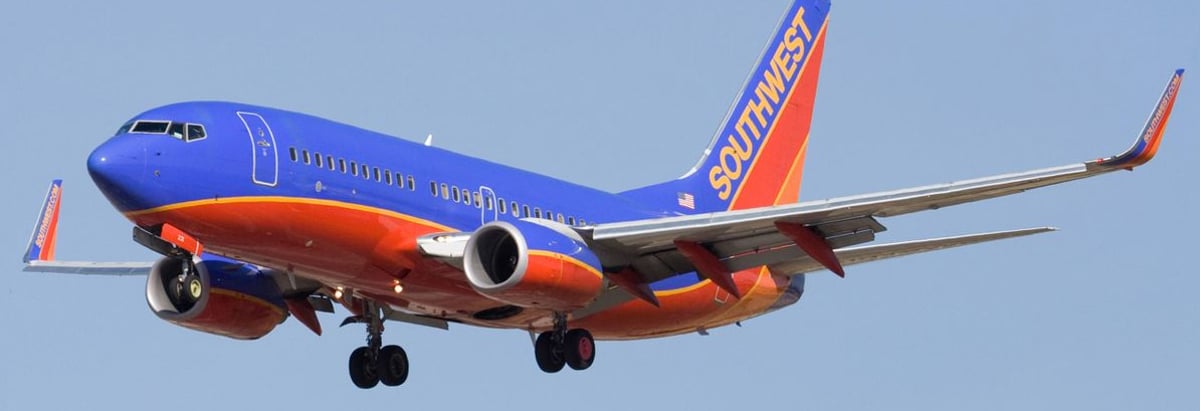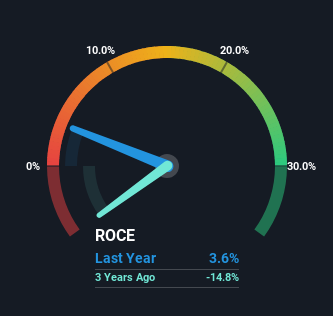- United States
- /
- Airlines
- /
- NYSE:LUV
The Returns On Capital At Southwest Airlines (NYSE:LUV) Don't Inspire Confidence

What are the early trends we should look for to identify a stock that could multiply in value over the long term? Ideally, a business will show two trends; firstly a growing return on capital employed (ROCE) and secondly, an increasing amount of capital employed. Put simply, these types of businesses are compounding machines, meaning they are continually reinvesting their earnings at ever-higher rates of return. In light of that, when we looked at Southwest Airlines (NYSE:LUV) and its ROCE trend, we weren't exactly thrilled.
Understanding Return On Capital Employed (ROCE)
For those who don't know, ROCE is a measure of a company's yearly pre-tax profit (its return), relative to the capital employed in the business. To calculate this metric for Southwest Airlines, this is the formula:
Return on Capital Employed = Earnings Before Interest and Tax (EBIT) ÷ (Total Assets - Current Liabilities)
0.036 = US$879m ÷ (US$36b - US$12b) (Based on the trailing twelve months to December 2023).
So, Southwest Airlines has an ROCE of 3.6%. Ultimately, that's a low return and it under-performs the Airlines industry average of 10%.
See our latest analysis for Southwest Airlines

Above you can see how the current ROCE for Southwest Airlines compares to its prior returns on capital, but there's only so much you can tell from the past. If you'd like, you can check out the forecasts from the analysts covering Southwest Airlines for free.
So How Is Southwest Airlines' ROCE Trending?
In terms of Southwest Airlines' historical ROCE movements, the trend isn't fantastic. Over the last five years, returns on capital have decreased to 3.6% from 17% five years ago. However it looks like Southwest Airlines might be reinvesting for long term growth because while capital employed has increased, the company's sales haven't changed much in the last 12 months. It may take some time before the company starts to see any change in earnings from these investments.
The Bottom Line On Southwest Airlines' ROCE
Bringing it all together, while we're somewhat encouraged by Southwest Airlines' reinvestment in its own business, we're aware that returns are shrinking. Since the stock has declined 32% over the last five years, investors may not be too optimistic on this trend improving either. Therefore based on the analysis done in this article, we don't think Southwest Airlines has the makings of a multi-bagger.
On a final note, we found 2 warning signs for Southwest Airlines (1 shouldn't be ignored) you should be aware of.
For those who like to invest in solid companies, check out this free list of companies with solid balance sheets and high returns on equity.
New: Manage All Your Stock Portfolios in One Place
We've created the ultimate portfolio companion for stock investors, and it's free.
• Connect an unlimited number of Portfolios and see your total in one currency
• Be alerted to new Warning Signs or Risks via email or mobile
• Track the Fair Value of your stocks
Have feedback on this article? Concerned about the content? Get in touch with us directly. Alternatively, email editorial-team (at) simplywallst.com.
This article by Simply Wall St is general in nature. We provide commentary based on historical data and analyst forecasts only using an unbiased methodology and our articles are not intended to be financial advice. It does not constitute a recommendation to buy or sell any stock, and does not take account of your objectives, or your financial situation. We aim to bring you long-term focused analysis driven by fundamental data. Note that our analysis may not factor in the latest price-sensitive company announcements or qualitative material. Simply Wall St has no position in any stocks mentioned.
About NYSE:LUV
Southwest Airlines
Operates as a passenger airline company that provides scheduled air transportation services in the United States and near-international markets.
Fair value with moderate growth potential.
Similar Companies
Market Insights
Community Narratives


